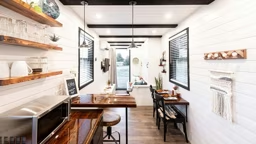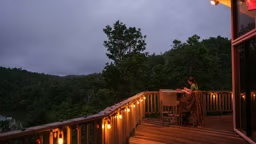Rob Estrada left Los Angeles in the summer of 2003 on a fateful journey to northern Arizona. After visiting the Grand Canyon, he took a tour of Montezuma’s Castle, a local archaeological site that showcases one of the best-preserved cliff dwellings in North America.
This 20-room, five-level “apartment” — built by the Sinagua people 1,000 years ago — is a wonder of ingenuity and craftsmanship, and it got Estrada thinking about his own desire for an Arizona home.
Staking a Claim
Estrada purchased a 28-acre lot in Coconino County’s Howard Mesa Ranch, located between Sedona, Ariz., and the Grand Canyon. The ranch is a collection of 10- to 40-acre lots that border a national forest.
The lot was situated on dry, open grassland sprinkled with pinion pine and juniper. Herds of elk and antelope could often be found grazing in the area. Plus, the land has spectacular views of the highest mountains in Arizona, the San Francisco Peaks.
But, now that he had the perfect spot for his cabin, he needed to figure out what his cabin would be.
Size and footprint were the first considerations. “I sat down and decided that I don’t need that much space to be comfortable,” says Estrada. “So I decided on a two-bedroom, one-bath plan with a traditional ranch design.”
The next questions for Estrada: How and what? “I stressed to my general contractor that whenever possible, I wanted to use local materials and have the optimum energy-efficient construction techniques.”
Going Off the Grid
“When planning the project, I wanted it to be green from the get-go. As it was my escape pad from L.A., I felt that I needed to go all the way with this and have my own sources of fuel, water and power.”
Since Estrada wanted an off-grid and self-sufficient cabin, he decided to go with solar, rather than generators, as his primary energy source.
Going off the grid wasn’t just a smart move environmentally; it was also a cost saver. If Estrada decided to get electricity from the local utility company, he would have had to pay about $17,000 just to get the power line to his property.
But that doesn’t mean building a solar cabin was easy ... or cheap.
“The County decided that since so many people in the area were taking on solar projects, they wanted to make sure to make it as safe as possible. They had a fear of fire danger from the electronic components in the home, so they required a special room to be used for the solar inverters, batteries and controllers. This threw me a major curve ball that I did NOT budget for!”
Solar Shopping
Still, Rob pressed forward with his plans, picking the brain of an electrician friend and then shopping around on the Internet for pricing on the equipment he needed.
“I wanted to have a minimum amount of power to support my water pump, my low-amperage apartment model refrigerator and a few lights and small appliances.”
“I have two 80-watt panels, four 12-volt batteries, an 1800-watt inverter, a digital controller mounted on a pole on the roof which tracks with the sun and a 7,000-watt Honda generator for emergencies,” says Rob. “Also, there is plenty of wind in the area, so a turbine is a serious option down the line.”
Rob estimates he spent around $4,000 on the solar portion of the cabin, not including the construction of the county-mandated special room to house the solar equipment. And while solar panels and inverters are generally on the expensive side, the U.S. Department of Energy claims that most users recoup the initial cost through the substantial utility cost savings within 15 years.
Saving Money . . . and Energy
Rob also found ways to save money in other aspects of construction. “I used plywood siding made from local lodgepole pine for the construction. This was less expensive than the log cabin route, and provides better insulation while protecting old growth forests. I also used local flagstone for flooring as opposed to more expensive travertine, which has to be shipped in from other regions.”
And even after dealing with the myriad mistakes and setbacks common to any construction project, Rob still feels he’s made the right decision to build his green cabin in the shadow of the Grand Canyon.
“I’m reminded of what my friend Jonathon Day (a Hopi Elder) said, that ‘the Colorado Plateau is sacred land.’”
And when the sun rises each morning on Montezuma’s Castle, that ancient wonder of ingenuity and craftsmanship, it now also rises on Rob Estrada’s cabin — one built with the ingenuity and craftsmanship of modern times.
Editor Andy Bennett dreams of going off grid, but only if he can take his plasma television with him.










